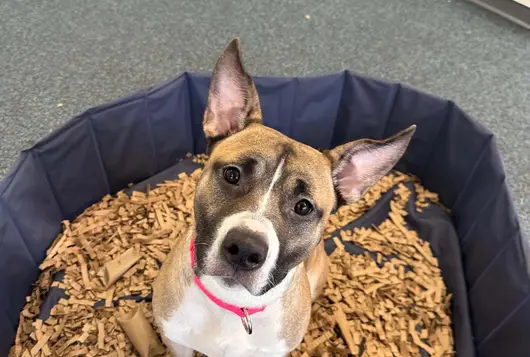The Daily Change-Up

Mackenzie's Animal Sanctuary incorporates daily in-kennel enrichment for their dogs into routine activities that shelter staff already perform, such as cleaning kennels and feeding.
Daily kennel enrichment focuses on three sources of sensory stimulation:
- A different scent for each day of the week (olfactory stimulation)
- Classical music playing in the background (auditory stimulation)
- A different toy each day of the week (varied stimulation depending on the toy)
Variety is key to the success of enrichment, and is itself enriching. Modest but pleasant changes in the dog's environment help prevent dogs from becoming at-risk behaviorally during their stay at the shelter. Mackenzie's varies the scents, music, and toys daily, and would do it more frequently if they had a larger staff.
Remember that enrichment is enriching only when the animal chooses to interact with it and it has the desired effect. Have a variety of types of stimulation at your disposal to keep things interesting for all your canines. Closely monitor the effect of introduced sounds and scents on individual animals because they cannot avoid them if they choose.
Click a link below to see the details of each form of daily in-kennel enrichment.
Scent of the Day
You can introduce a different scent each day as part of kennel cleaning.
Materials
- Spray bottles and containers with shaker tops
- Cooking extracts, such as vanilla, peppermint, almond, coconut, etc.
- Sweet spices, such as cinnamon, nutmeg, clove, cardamom
Check out warehouse stories to obtain extracts and spices in bulk sizes. You can also try aromatherapy extracts and oils, but be sure to research these carefully before using them in the shelter. Some aromatherapy substances are irritants or even toxic to animals (although more likely to affect cats than dogs).
People
Volunteers can prepare the bottles or shakers with the scents of the day and distribute the enrichment to the dogs on the adoption floor. Animal care staff can introduce the scents during kennel cleaning to pre-adoption dogs.
What to Do
- Prepare the scents.
- Assemble as many spray bottles as you have liquid extracts.
- Fill each bottle nearly full with water, and then add a small amount of extract, and mix. Remember that dogs have a keen sense of smell, so the concentration of extract can be very small.
- If you have dry spices, transfer each to a container with a shaker top.
- Include the bottle or shaker of the scent of the day with your kennel cleaning supplies. You could also designate an enrichment cart that contains the various enrichment items for the kennels and a copy of your enrichment schedule. (Mackenzie's has an enrichment wagon.)
- In each kennel, after cleaning, lightly spray the walls and floor with the diluted extract. If the scent of the day is a dry spice, sprinkle small amounts on bedding or toys.
You may find that some scents are not well received. Remove these from the rotation, and try something else. If individual dogs do not interact with certain scents, or display aversion toward them, you can record this on the enrichment schedule.
The Sound of Music
Some classical music can be soothing and calming to dogs who have been in the shelter for a long time. Some music, such as heavy metal, may actually increase vocal behavior and agitation, and decrease resting. Recordings of household sounds and children may help acclimate puppies and kittens to their future homes. Natural sounds like birdsong may be interesting to bored, long-stay residents or in very quiet shelters.
Materials
- A selection of slow-tempo classical music, household sounds, and natural sounds CDs
- Portable CD players placed near individual animals' kennels. This permits better targeting of enrichment to suitable animals than using the shelter's public address system.
People
All you need here is someone to change the CDs from time to time and to turn them off after a few hours.
What to Do
Play the tunes.
Because shelter animals cannot avoid introduced sounds if they choose, it's important to monitor the effect of introduced sounds on individual animals. In some shelters and for some animals, reduction of sound may be more calming than introducing additional sounds. All animals should have quiet time each night. Be aware that if the same CD plays all day every day, the animals will filter it out. Strive for some variety in the CDs and alternate them with quiet time.
Observe whether any of your selections increase vocal behavior and agitation among dogs (or withdrawal among cats). If so, remove these selections from the rotation. Add more choices that are similar to the music that doesn't inspire the dogs to "sing" along (or cats to climb the walls).
The Magic Toy Box
Rotating toys through the kennels is an easy way to make kennel life more interesting for shelter dogs.
Materials
A variety of dog toys, such as Booda™ bones, Nylabones™, plush toys, balls, etc.
People
Your animal care staff can swap out toys as part of their daily kennel cleaning.
What to Do
Due to limited staff, Mackenzie's staff changes the toys in each kennel daily. You can change the toys more frequently if you have the time. For example, in addition to swapping toys during cleaning, you can replace the toys a second time when dogs leave their kennels for daily exercise. That way, when they return to the kennel, they find a different toy waiting for them.
An enrichment schedule can be very helpful for tracking the rotation of toys so that all dogs see a different toy each day. You can also note individual preferences and needs.
Remember that it's not enrichment if the dog doesn't interact with the toy. If a dog doesn't show interest in a certain toy or type of toy, remove it and try a different kind of toy. Record these preferences on your enrichment schedule.
View a sample enrichment schedule.
We have lots more on this subject:




